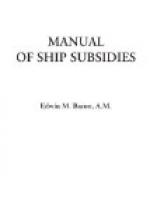The subsidy, or rate of compensation, as it is termed, for mail-carriage is thus fixed in each class: first class, not exceeding four dollars (in the original draft six dollars) a mile; second class, two dollars a mile, by the shortest practicable route for each outward voyage; third class, one dollar a mile; fourth class, two-thirds of a dollar a mile for the actual number of miles required by the Post Office Department to be travelled on each outward bound voyage. Pro rata deductions from the compensations, and penalties, are imposed for omission of a voyage or voyages, and for delays or irregularities in service. No steamship in the contract service is to receive any other bounty or subsidy from the national treasury. Sanction is given to naval officers to volunteer for service on the contract mail steamships; and, while so employed, they are to receive furlough pay in addition to their steamship pay, provided they are required to perform such duties as appertain to the merchant service. The training-school for seamen is established by a provision requiring that the contract steamers “shall take cadets or apprentices, one American-born boy for each thousand tons gross register, and one for each majority fraction thereof, who shall be educated in the duties of seamanship, rank as petty officers, and receive such pay for their services as may be reasonable."[HN]
The first advertisements for proposals under this act resulted in contracts with eleven existing lines, of the third and fourth classes. No bids were received for the North Atlantic service calling for American-built steamships in the first class. But an offer was made by the American Line[HO] to begin the performance of the service with two British-built liners—the City of New York and the City of Paris—acquired from the Inman Line, if these steamers were admitted to American registry, the company agreeing immediately to order two similar ships from American shipyards and add these to their fleet. The proposition was accepted, and a supplementary act was passed (May 10, 1892), legalizing such registry.[HP] The new American ships were promptly built,—the St. Louis and the St. Paul, launched November, 1894, and April, 1895, respectively,—each 11,600 tons, “larger, swifter, safer, and more luxurious"[HQ] than the two British-built vessels: a perfection of workmanship deemed a matter for congratulation by patriotic Americans. To this extent at least the subsidy law was declared to have been beneficent.
It had become evident, however, that the law was not fostering the establishment of new American-owned and American-built steamship lines as its promoters had hoped. In 1893 the contract service had been reduced by the discontinuance of three of the routes. In 1894 only three contracts were in operation. Up to 1898 no lines had been established on the Pacific under the law.
In the judgment of the subsidy advocates the law’s failure to produce the anticipated results only proved its inadequacy in not providing enough subsidy. Accordingly, further measures were proposed affording a more generous supply.




